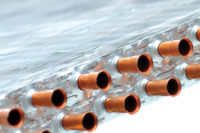On one hand, few of the 347 papers presented had much to say about HFC refrigerants such as the familiar R-134a and R-410A other than to say that their perceived high global warming potential (GWP) could make them subject to a worldwide phase-down. One report speculated on a phase-down to 15 percent of current production levels by 2035 in developed countries such as the United States and Canada.
Yet at the same time, the most talked-about refrigerant was also an HFC. R-32 has long been used in blends but was being proposed in close to a dozen papers as a viable stand-alone alternative in applications that have long used R-134a, R-410A, and HCFC-22. Advocates said this was because of its performance characteristics and lower GWP (675 vs. 2088 for R-410A) even though it carries an A2L (slightly flammable) safety rating.
In all, a record 580 persons attended the four days encompassing the air conditioning, refrigeration, buildings, and compressor conferences presented by Purdue University on its West Lafayette, Ind., campus. Papers covered the gamut including noise, vibration, lubrication, and valves along with equipment innovations in the compressor presentations; heat transfers, heat exchangers, and system performance in the refrigeration and air conditioning track; and energy modeling, net zero, and airflow modeling in the buildings sector.
It was the talk about the future of HFCs — as well as a comparatively low GWP HFC — that might hold the most interest to contractors and service technicians.
The scientific papers did not speculate much on regulatory issues related to GWP being factored into any phase-down or wider acceptance of A2L refrigerants in the United States. They mainly focused on how the refrigerant would work in a wide range of applications.
Papers
A paper from Danfoss research and development departments in China and France had this conclusion: “Compared to other candidate refrigerants, R-32 is an attractive option from an environmental perspective and a mechanical point of view. R-32 has good thermodynamic properties to improve COP [coefficient of performance] improvement. There is not excessive increase of pressure and loads and high discharge temperature can be controlled by liquid injection.”
As noted by presenter Chao Yan concerning applications in scroll compressors, “At high-pressure ratio conditions, the strength requirement of scroll sets can be reduced due to smaller pressure differences. But lubricants should be requalified on the miscibility and tropology side. With these considerations, R-32 is likely to become a major alternative refrigerant in the future for air conditioning and heat pump applications in many countries under HFC regulatory caps.”
It was the lower GWP of R-32 that was the attention getter for researchers at Emerson Climate Technologies in the United States. In a paper presented by Hung Pham, it was noted, “On the basis of efficiency and cost, R-32 offers an attractive low-GWP/low-LCCP (life cycle climate performance) solution for mainstream air conditioning and heat pump applications with performance comparable to R-410A.
“This is based on drop-in evaluation with R-410A optimized components and could be potentially improved by further optimizing the compressor and system toward achieving its theoretical potential as well as mitigating its higher compressor discharge temperature and finding new compatible oils. Its GWP of 675 can be equivalent to 500 GWP when factoring in its 15 percent lower system charge. Its heat transfer and pressure drop characteristics are synergistic with the direction of lower-charge, lower-leak compact heat exchangers for further mitigating the GWP phase-down as well as the A2L flammability.”
The Emerson report did acknowledge the uncertainty about factoring an acceptable GWP level into any proposed phaseout. “R-32 can serve as the initial candidate for new equipment to meet any potential HFC phase-down proposal for at least until 2020 and beyond. It is still uncertain what GWP will ultimately be needed to meet the suggested 15 percent cap proposal by 2030+ due to uncertain future R-410A buildup in the aftermarket service sector.”
Emerson also presented similar performance data on three other low-GWP synthetic refrigerants that were candidates from Honeywell and DuPont and were labeled HFO Blends #1, #2 and #3. All of these blends were in regions of acceptable performance on a capacity vs. efficiency map shown by Emerson.
A paper from Emerson Climate Technologies in China focused on R-32’s potential use in that country. Said Weihua Guo, “R-32 could be a cost-effective, low-GWP/low-LCCP refrigerant solution for China’s air conditioning applications. Among all different R-32 compressor technologies, vapor injection technology has inherent advantages in both efficiency and reliability. It provides 7 to 9 percent efficiency gain at rated heating, while comparable efficiency at rated cooling condition, compared to noninjection technology. Through EVI (economized vapor injection) technology, the ability to control discharge temperature has been enhanced. However, considering the diversity of China’s air conditioning systems and the sensitivity on system cost, managing discharge temperature without injection is attractive for R-32 system builders. As a third alternative, liquid injection is another solution. Although liquid injection cost less compared to an EVI system, it potentially has a performance penalty.”
Possibilities for R-32 in retrofits were part of a study done at Oklahoma State University. As noted by presenter Atharva Barve, “The findings suggested that for refrigerant drop-in applications, R-32 has comparable heating and cooling capacities as those for R-410A and also similar COPs. The discharge pressures and discharge temperatures were higher than those for R-410A, especially for moderate to extreme high-temperature conditions. Too high discharge temperature and pressure of R-32 in extreme high temperature conditions was a concern for the safe operation of the unit and might be a concern for the compressor lifetime cycle. “
Another issue addressed in several papers was what oils to use with R-32 as a standalone refrigerant. In a paper from JX Nippon Oil of Japan, Takeshi Okido said, “A problem with current refrigeration oils for R-410A systems is that they have poor miscibility with R-32. Hoping to solve this problem, we tested POE oils with modified molecular structures and were able to develop new POE oils that showed outstanding miscibility with R-32.
“Another problem is the inferior lubricity of POE oils. When used in POE oils, EP additives do not adsorb well on sliding surfaces and thus anti-wear performance is lacking. To overcome this problem, we developed a new assistant (additive) that promotes the adsorption of EP additives, and found that it greatly improved the anti-wear performance of POE oils. The new POE oils were developed by combining these technologies. These new refrigeration oils can be used with both next-generation R-32 and current R-410A refrigerants.”
Publication date: 9/3/2012








Report Abusive Comment